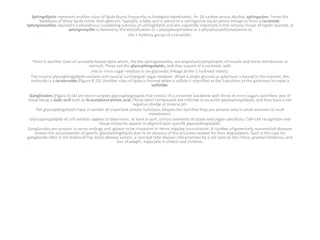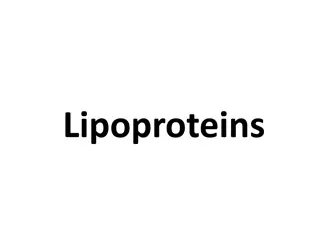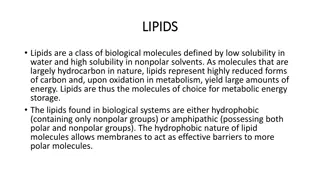Introduction to Lipids and Their Importance in Biological Systems
Lipids encompass a diverse group of compounds such as fats, oils, steroids, and waxes with unique properties making them pivotal in cell membranes and energy provision. Explore the nomenclature of fatty acids and the significance of delta naming systems.
Uploaded on Apr 24, 2025 | 0 Views
Download Presentation

Please find below an Image/Link to download the presentation.
The content on the website is provided AS IS for your information and personal use only. It may not be sold, licensed, or shared on other websites without obtaining consent from the author.If you encounter any issues during the download, it is possible that the publisher has removed the file from their server.
You are allowed to download the files provided on this website for personal or commercial use, subject to the condition that they are used lawfully. All files are the property of their respective owners.
The content on the website is provided AS IS for your information and personal use only. It may not be sold, licensed, or shared on other websites without obtaining consent from the author.
E N D
Presentation Transcript
Topic Lipids Presented by Ms. P. H. Giri Department of Microbiology Deogiri College, Aurangabad
B.SC. F. Y. SEMESTER II PAPER NO. V BASIC BIOCHEMISTRY UNIT 2 LIPIDS Ms. Priyanka H. Giri
INTRODUCTION: The lipids are a heterogeneous group of compounds, including fats, oils, steroids, waxes, and related compounds, which are related more by their physical than by their chemical properties. Lipids are a class of compounds distinguished by their insolubility in water and solubility in nonpolar solvents. Lipids have the common property of being relatively insoluble in water and soluble in nonpolar solvents such as ether and chloroform. Lipids are important in biological systems because they form the cell membrane, a mechanical barrier that divides a cell from the external environment. Lipids also provide energy for life and several essential vitamins are lipids.
DELTA NOMENCLATURE: The most commonly used systems for designating the position of double bonds in an unsaturated fatty acid is the delta ( ) numbering system. For example, cis- 9 means that there is a cis double bond between carbon atoms 9 and 10; trans- 2 means that there is a trans double bond between carbon atoms 2 and 3. In this nomenclature the carboxyl carbon is designated carbon 1. For example, palmitoleic acid has 16 carbons and has a double bond between carbons 9 and 10. It is designated as 16:1: 9.























